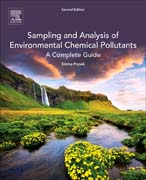
Sampling and Analysis of Chemical Environmental Pollutants, Second Edition examines data collection process fundamentals, offering technically solid procedures and basic techniques that can be applied to daily workflow solutions. The book centers on the basic underlying principles of environmental sampling and analytical chemistry and summarizes universally accepted industry practices and standards. Through a common sense, practical approach to field work and data interpretation coupled with detailed step-by step procedures for sampling of key environmental matrices, the book's procedures have been adapted from the EPA, DOD and DOE protocols and revised to reflect the true field conditions, the current state-of-the-art techniques and industry standards. Includes numerous call-out boxes containing practical tips about widely used industry practices, based on years of experience in the fieldProvides new case studies illustrating the complicated EPA Data Quality Objectives process and making it understandableAppendices detail the most frequently used action levels, calculation aides and checklists Features new subchapters on incremental soil sampling, groundwater sampling with diffusion bags, chemical data reporting and database managementAuthored by an analytical chemist and environmental pollutant expert with 30 years of experience in research and the field INDICE: 1.The Sample and the Error 1.1. The Concept of Relevant and Valid Data 1.2. Importance of a Stepwise Approach 1.3. Seven Steps of the Sample's Life 1.4. Total Error and Its Sources 1.5. Total Error and Data Usability 2. Environmental Chemical Pollutants 2.1. Pollutant Classification 2.2. Physical and Chemical Properties and Fate and Transport Indicators 2.3. Volatile Organic Compounds 2.4. Persistent Organic Pollutants 2.5. Toxic Metals 2.6. Regulatory Overview and Action Levels 3. Bird's Eye View of Project Planning 3.1. What are Data Quality Objectives? 3.2. Definitive, Screening, and Effective Data 3.3. How to Navigate the Analytical Method Maze 3.4. Sampling Strategies 3.5. Field Quality Control and Quality Assurance Samples 3.6. Cost Estimate 3.7. Planning Documents 3.8. Analytical Method and Laboratory Selection 3.9. Preparedness and Coordination 4. Practical Approach to Sampling 4.1. Seven Steps of the Sampling Process 4.2. Sample Custody and Tracking 4.3. Sample Preservation Techniques 4.4. Sample Packaging and Shipment 4.5. Soil Sampling Designs and Methods 4.6. Water Sampling 4.7. Surface Sampling with Wipes 4.8. Equipment Decontamination 4.9. Field Measurements 4.10. Field Records 5. Understanding the Analytical Laboratory 5.1. Requirements for Laboratory Operation 5.2. Laboratory Organization 5.3. The Seven Steps of Laboratory Process 5.4. Analytical Techniques and Their Applications 5.5. Compound Quantitation 5.6. Laboratory Quality Assurance 6.0. Data Quality Assessment 6.1. Data Evaluation 6.2. The Seven Steps of Data Evaluation 6.3. The Seven Steps of the Data Quality Assessment
- ISBN: 978-0-12-803202-2
- Editorial: Elsevier
- Encuadernacion: Rústica
- Páginas: 380
- Fecha Publicación: 01/10/2017
- Nº Volúmenes: 1
- Idioma: Inglés
